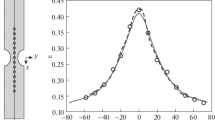Abstract
A fiber optic sensor capable of measuring two independent components of transverse strain is described. The sensor consists of a single Bragg grating written into high-birefringent, polarization-maintaining optical fiber. When light from a broadband source is used to illuminate the sensor, the spectra of light reflected from the Bragg grating contain two peaks corresponding to the two orthogonal polarization modes of the fiber. Two independent components of transverse strain in the core of the fiber can be computed from the changes in wavelength of the two peaks if axial strain and temperature changes in the fiber are zero or known. Experiments were performed to determine the response of the sensor by loading an uncoated sensor in diametral compression over a range of fiber orientations relative to the loading. The results of these experiments were used with a finite element model to determine a calibration matrix relating the transverse strain in the sensor to the wavelength shifts of the Bragg peaks. The performance of the sensor was then verified by measuring the transverse strains produced by loading the fiber in a V-groove fixture.
Similar content being viewed by others
References
Udd, E., “An Overview of Fiber-optic Sensors,”Rev. Sci. Inst.,66 (8),4015–4030 (1995).
Kim, K.-S., Kollar, L., andSpringer, G.S., “Model of Embedded Fiber Optic Fabry-Perot Temperature and Strain Sensors,”J. Composite Mat.,27 (17),1618–1662 (1993).
Sirkis, J.S., “Unified Approach to Phase-strain-temperature Models for Smart Structure Interferometric Optical Fiber Optic Sensors: Part 1. Development,”Opt. Eng.,32 (4),752–761 (1993).
Sirkis, J.S., “Unified Approach to Phase-strain-temperature Models for Smart Structure Interferometric Optical Fiber Sensors: Part 2. Applications,”Opt. Eng.,32 (4),762–773 (1993).
Wagreich, R.B., Atia, W.A., Singh, H., andSirkis, J.S., “Effects of Diametric Load on Fibre Bragg Gratings Fabricated in Low Birefringent Fiber,”Electronics Lett.,32 (13),1223–1224 (1996).
Sirkis, J.S. andLo, Y., “Simultaneous Measurement of Two Strain Components Using 3×3and 2×2Coupler-based Passive Demodulation of Optical Fiber Sensors,”J. Lightwave Tech.,12 (12),2153–2161 (1994).
Singh, H. andSirkis, J.S., “Dual-parameter Optical Fiber Sensor,”Smart Structures and Materials 1995: Smart Structures and Integrated Systems,SPIE 2443,258–265 (1995).
Lawrence, C.M., Nelson, D.V., andUdd, E., “Multi-parameter Sensing with Fiber Bragg Gratings,”Proceedings of the Second Pacific Northwest Fiber Optic Sensor Workshop,SPIE 2872,24–31 (1996).
Morey, W.W., “Fiber Optic Grating Technology,”Proceedings of the Pacific Northwest Fiber Optic Sensor Workshop,SPIE 2574,22–31 (1995).
Kersey, A.D., Davis, M.A., Patrick, H.J., LeBlanc, M., Koo, K.P., Askins, C.G., Putnam, M.A., andFriebele, E.J., “Fiber Grating Sensors,”J. Lightwave Tech.,15 (8)1442–1463 (1997).
Lo, Y.L., Sirkis, J.S., andRitchie, K.T., “A Study of the Optomechanical Response of a Diametrically Loaded High-birefringent Optical Fiber,”Smart Mat. Struct.,4,327–333 (1995).
Olson, G.A. andMetcalf, J.L., “Parametric Analysis of Elastooptic Birefringent Axis Alignment in Eccentrically Coated Polarization-maintaining Optical Fiber,”Appl. Opt.,31 (9)1234–1238 (1992).
Carrara, S.L.A., Kim, B.Y., andShaw, H.J., “Elasto-optic Alignment of Birefringent Axes in Polarization-holding Optical Fiber,”Opt. Lett.,11 (7),470–472 (1986).
Timoshenko, S. andGoodier, N., Theory of Elasticity, McGraw-Hill, New York (1951).
Strang, G., Linear Algebra and Its Applications, Harcourt Brace Jovanovich, San Diego, CA (1988).
Jin, W., Michie, W.C., Thursby, G., Konstantake, M., andCulshaw, B., “Simultaneous Measurement of Strain and Temperature: Error Analysis,”Opt. Eng.,36 (2),598–609 (1997).
Liu, T., Fernando, G.F., Rao, Y.J., Jackson, D.A., Zhang, L., andBennion, I., “Simutaneous Strain and Temperature Measurements in Composites Using a Multiplexed Fibre Bragg Grating Sensor and Extrinsic Fabry-Perot Sensor,”Smart Structures and Materials 1997: Smart Sensing, Processing, and Instrumentation,SPIE 3042,203–212 (1997).
Xu, M.G., Archambault, J.-L., Reekie, L., andDakin, J.P., “Discrimination Between Strain and Temperature Effects Using Dual-wavelength Fibre Grating Sensors,”Electronics Lett.,30 (13),1085–1087 (1994).
James, S.W., Dockney, M.L., andTatam, R.P., “Simultaneous Independent Temperature and Strain Measurement Using In-fibre Bragg Grating Sensors,”Electronics Lett.,32 (12),1133–1134 (1996).
Author information
Authors and Affiliations
Rights and permissions
About this article
Cite this article
Lawrence, C.M., Nelson, D.V., Udd, E. et al. A fiber optic sensor for transverse strain measurement. Experimental Mechanics 39, 202–209 (1999). https://doi.org/10.1007/BF02323553
Received:
Revised:
Issue Date:
DOI: https://doi.org/10.1007/BF02323553



